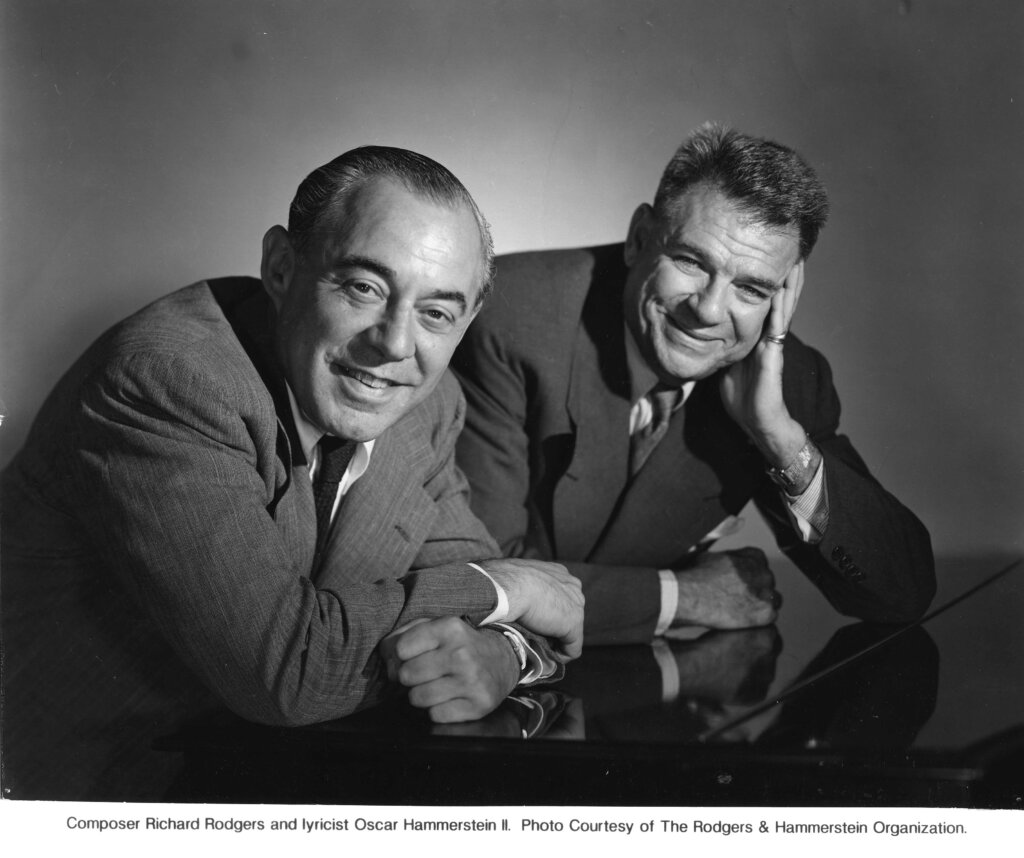A Rodgers & Hammerstein Timeline

How much do you know about Rodgers & Hammerstein? Before working together, Richard Rodgers and Oscar Hammerstein II had separately built distinguished careers. Richard Rodgers had been in a writing partnership with lyricist Lorenz (Larry) Hart for 24 years, co-creating over 40 musicals and film scores. Oscar Hammerstein II had built a distinguished career bringing new life to operetta, working with such composers as Rudolf Friml, Sigmund Romberg, Vincent Youmans and Jerome Kern. More recently, however, Hammerstein had suffered a series of commercial failures. All that changed one afternoon when an old friend visited his farm for an impromptu conversation. What followed would change the course of American musical theater.
1940
Larry Hart, suffering from depression and alcoholism, was in steep decline. Rodgers, worried that Hart would be unable to work, drove out to the farm of his old friend Oscar Hammerstein II to talk about creating a project together –in effect asking Hammerstein, “May I have the next dance?”
1943
Their opportunity came nearly two years later, when the Theater Guild approached Rodgers about creating a musical adaptation of Green Grow the Lilacs. With Hart in no condition to work, Rodgers approached Hammerstein about coming on as his collaborator on a project later to be titled Oklahoma!
Rodgers and Hammerstein felt confident about the project, but they had trouble convincing investors to come on board. Rodgers had previously worked exclusively with Hart, and potential investors were nervous about this new, untested partnership. Beyond this, the names attached to the project were of doubtful merit. The Theater Guild for several years had been producing commercial failures; Oscar Hammerstein II had not had a success in nearly 11 years, and the cast members were relatively unknown.
March 31, 1943
Oklahoma! opened on Broadway and became an instant smash hit.
1943 – 1945
For Rodgers & Hammerstein’s next project, The Theater Guild had a suggestion – a musical adaptation of the Hungarian play Liliom by Ferenc Molnár. Initially reticent, the pair eventually conceded after pushing to have the play’s setting changed from Hungary to the New England coast. They decided to call the project Carousel.
April 19, 1945
Carousel opened on Broadway and ran for 890 performances. Although not the mega-hit that Oklahoma! was, the show continues to move audiences today.
August 20, 1945
State Fair, the first Rodgers & Hammerstein show created exclusively for film, premiered at the Roxy Theater in New York City. A musical adaptation of 20th Century Fox’s 1933 comedy of the same name, the story, the screenplay and the lyrics were written by Oscar Hammerstein II, with a score by Richard Rodgers.
1946
Hammerstein approached Rodgers with an idea that would transform American musical theater: a concept musical, focusing on an average man struggling to maintain his ideals in the face of success in his field. The musical would later be titled Allegro.
October 10, 1947
Allegro opened on Broadway, boasting the largest advance ticket sales of any Broadway show due to its legendary out-of- town runs in New Haven and Boston. Although it ran for only a year, the musical left an indelible mark on musical theater, inspiring future concept musicals such as Cabaret, Hair, Company, A Chorus Line and more.
April 7, 1949
South Pacific, based on the short stories by James Michener, opened at the Majestic Theater on Broadway, starring Mary Martin, Enzio Pinza, Juanita Hall and Myron McCormick – all of whom would go on to win Tony Awards for their roles. The musical won the Pulitzer Prize in 1950, becoming only the second musical ever to do so.
Early 1950s
British actress Gertrude Lawrence approached Rodgers and Hammerstein about adapting the novel Anna and The King of Siam into a musical. Rodgers and Hammerstein agreed and reached out to various Hollywood stars to cast as the King. Having been turned down by Noel Coward, Rex Harrison and Alfred Drake, the team auditioned television director Yul Brynner and were immediately smitten.
March 29, 1951
The King and I opened on Broadway. The show ran for over three years and won five Tony Awards. Yul Brynner would be forever identified with the role of the King of Siam. He played the role more than 4,600 times, first in the stage production and then on film and television, eventually earning an Oscar for his portrayal in the 1956 film.
May 28, 1953
Me and Juliet, an introspective peek behind the curtain at a fictional, long-running Broadway show, opened on Broadway. The show marked a departure in style for the team, and although it is one of their lesser-known works, it helped popularize backstage comedies.
November 30, 1955
Pipe Dream, based on John Steinbeck’s novel Sweet Thursday and featuring characters from Cannery Row, opened at the Shubert Theater on Broadway. Nominated for nine Tony Awards, the musical closed on June 30, 1956 after 246 performances.
March 31, 1957
CBS presents a live broadcast of a new musical created exclusively for television — Cinderella, starring Julie Andrews. Inspired by NBC’s successful telecast of Peter Pan, CBS sought to replicate the NBC ratings boom by commissioning an exclusive work from Rodgers & Hammerstein, whose reputation as hitmakers was only growing following the success of Oklahoma!, South Pacific and The King and I. The television program was a smash hit and was watched live by 107 million Americans.
December 1, 1958
Flower Drum Song, based on the novel by C.Y. Lee, opened at the St. James Theater as the first Broadway musical to feature a primarily Asian American cast: Pat Suzuki, Miyoshi Umeki, Jose Ahumada, Fumi Akimoto, Paula Chin and others. The show ran for over 600 performances on Broadway before closing in 1960.
November 16, 1959
Rodgers & Hammerstein, ready with a new musical they called Love Song, were begged by their attorney to change the title due to copyright issues. So, the duo retitled their musical about the Trapp Family Singers to The Sound of Music. The show opened at the Lunt-Fontanne Theatre on Broadway on November 16th, 1959. The concept of the musical was brought to them by Mary Martin, who asked the duo to create a few songs for a play she was writing about Maria von Trapp. Rodgers and Hammerstein so loved the idea that they decided to turn it into a full-length musical starring Mary Martin. The original 1959 production would win four Tony Awards, and the show would eventually find new life in the 1965 motion picture starting Julie Andrews. The Sound of Music would be the final Rodgers & Hammerstein collaboration.
August 23, 1960
Oscar Hammerstein II died on his farm in Doylestown, Pennsylvania at the age of 65. After Hammerstein’s death, Richard Rodgers wrote the music for several more musicals — No Strings, Do I Hear a Waltz?, Two by Two, Rex and I Remember Mama.
December 30, 1979
Richard Rodgers died in New York City at the age of 77.
Collectively, the works of Richard Rodgers and Oscar Hammerstein II have won 42 Tony Awards, 15 Academy Awards, two Pulitzer Prizes, two Grammy Awards and 2 Emmy Awards.








